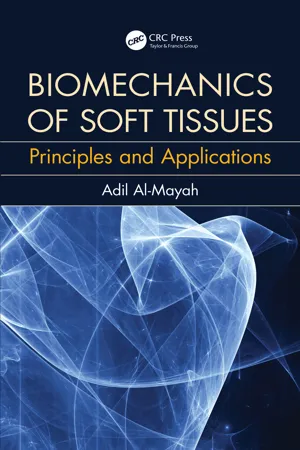
- 176 pages
- English
- ePUB (mobile friendly)
- Available on iOS & Android
About This Book
The emerging paradigm of incorporating images and biomechanical properties of soft tissues has proven to be an integral part of the advancement of several medical applications, including image guided radiotherapy and surgery, brachytherapy, and diagnostics. This expansion has resulted in a growing community of medical, science, and engineering professionals applying mechanical principles to address medical concerns. This book is tailored to cover a range of mechanical principles, properties, and applications of soft tissues that have previously been addressed in various journals and "anatomical site-specific" books. Biomechanics of Soft Tissues follows a different approach by offering a simplified overview of widely used mechanical models and measuring techniques of soft tissue parameters. This is followed by an investigation of different medical applications, including: biomechanical aspects of cancerous tumor progressions, radiotherapy treatment, and image guided ultrasound guided interventions. Written by leading scholars and professionals in the field, Biomechanics of Soft Tissues combines engineering and medical expertise, thereby producing an excellent source of information for professionals interested in the theoretical and technological advancements related to soft tissues. The book provides medical professionals with an insight on various modeling approaches, testing techniques, and mechanical characteristics that are frequently used by engineers. Conversely, the presented medical applications provide engineers with a glimpse of amazing medical practices and encourage them to expand their roles in the medical field.
-
- Provides a simplified overview of mechanics of soft tissues.
-
- Highlights different techniques to measure tissues properties for engineering and medical applications.
-
- Contains novel ideas to address roles of mechanics in disease progression and treatment.
-
- Presents innovative applications of biomechanics in medical procedures.
Frequently asked questions
Information
Table of contents
- Cover
- Half Title
- Title Page
- Copyright Page
- Table of Contents
- Preface
- Editor
- Contributors
- 1 Mechanical Characteristics of Soft Tissues
- 2 Mechanical Investigations of Biological Tissues Using Tensile Loading and Indentation
- 3 Magnetic Resonance Elastography
- 4 Biomechanics of Cancer
- 5 Biomechanical Modeling Applications in Image-Guided Radiotherapy
- 6 3D Ultrasound-Guided Interventions
- Index